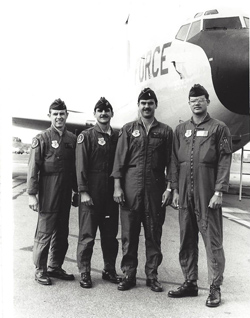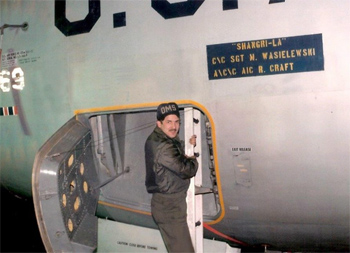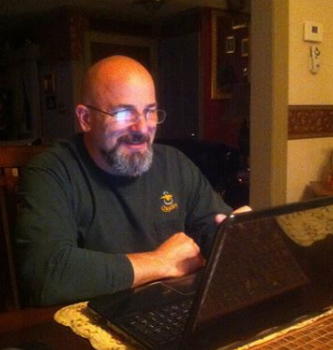Picture this: Two airplanes hover in the air midway across the Atlantic ocean. One is a military version of Boeing commercial passenger plane. The other, an F‑4 Phantom fighter jet with only one working engine.
Saddled with mechanical issues, the F‑4 is flying at a virtual crawl, trying to make it more than 500 miles to Newfoundland for an emergency landing.
The larger plane — a refueling tanker loaded with more than 70,000 pounds of fuel — has its landing gear down, the engines at idling speed, trying to slow down enough to match the jet’s speed and attempt a tow.
If the F‑4 doesn’t hook on, the two pilots inside will almost certainly die in the icy waters of the Atlantic.
It sounds like the climax of an action movie, but the scene is from the memory of Ansonia resident Ronald Craft, a former Air Force mechanic who was on that tanker Sept. 5, 1983.
He hopes to move the scene from his mind to the big screen.
“Over the years writing this, I pictured my movie to be better than ‘Top Gun,’ but real,” said Craft, 54.
Craft, a Shelton native who now works as a quality supervisor at Sikorsky, is raising money to publish a book, write a screenplay, and secure movie rights to the story.
He said he’s been working on it for the last 12 years, after he realized no one else from that mission was going to write the book.
Craft’s online IndieGoGo campaign seeks to raise some $50,000 for the book and screenplay, both of which he has tentatively named “Hell Over High Water.”
After struggling to write the book himself — “I’m not a writer. I’m barely a reader,” Craft said — he decided to hook up with Mark Roemmich, the CEO and president of Noble House Entertainment.
Roemmich, in a telephone interview from his company’s base in California, said he and Craft will co-write the book, and Roemmich will write the screenplay.
“I happen to do both,” Roemmich said.
He plans for the work to happen over the next six to 18 months.
The Flight
Craft was an airman first class stationed at Loring Air Force Base in Maine, working maintenance on the planes during his four-year stint with the Air Force.
In September 1983, Craft, then 23 years old, got his first chance to travel off base on a temporary duty trip escorting 24 F‑4 Phantom jets across the Atlantic Ocean on their way to an Air Force base in Germany.
The F‑4E fighter jets don’t have the capacity to fly long distances without refueling. So the trip required six tankers — Boeing KC-135s — to escort them, using mechanical fueling arms to refuel each of the jets eight times during the journey, Craft said.
Click play on the video to see an example of an F‑4 being refueled mid-flight.
Craft was the assistant crew chief on one of those tankers.
About halfway into the flight, one of the F‑4s had engine trouble, and started to make way for an emergency landing 520 miles away at Gander International Airport in Newfoundland, Canada, according to a write-up of the incident provided by the United States Air Force research office in Washington, D.C.
As the fighter jet made its way toward its target, an oil leak forced a total shutdown of one of the jet’s two engines. The refueling tanker that Craft was on turned around and flew toward the stricken F‑4E.
Captain Robert E. Goodman was the commander of the tanker, and said the crew should try to hook up the refueling boom to the fighter jet to help pull it along, according to the U.S. Air Force account.
Article continues after document:
KC-135 Tow by ValleyIndyDotOrg
At this point, because of the engine problems, the fighter jet was tilted at a 45-degree angle, Craft said, struggling to keep its altitude as it slowed down.
The tanker slowed down to 230 miles per hour — 50 percent slower than a normal flight speed — to try to connect to the F‑4E jet, according to the U.S. Air Force document.
“He had a little bit of lift, and he’s going so slow. A fighter can’t go that slow,” Craft said.
The slow speed put the fighter jet in danger of losing the lift it needed to stay airborne, which would have sent the plane plummeting into the ocean.
 The tanker was ultimately able to help the F‑4 reach safety by using its re-fueling arm to essentially tow the fighter jet part of the way.
The tanker was ultimately able to help the F‑4 reach safety by using its re-fueling arm to essentially tow the fighter jet part of the way.
It got pretty dicey at times, Craft said. He wants to save the most harrowing moments for the book.
He said simply: “We should have fallen out of the sky.”
The other members of the tanker’s flight crew were Captain Michael F. Clover, Captain Karol F. Wojcikowski, and Staff Sgt. Douglas Simmons. Craft and crew chief Michael Bouchard were the maintenance crew on hand during the rescue.
Craft said he was so young and inexperienced at in-flight missions that he thought this kind of activity was routine. He later realized the magnitude of what had happened: The flight crew saved the lives of two pilots in the F‑4, completing a rescue that had never been practiced.
Recognizing Veterans
Craft said he plans to dedicate the book to all service men and women for their everyday heroic deeds.
“What I’m trying to show with this book is this was just one of millions of incredible acts of bravery that are performed by our service men and women everyday,” Craft said. “It’s just their job.”
 He plans to distribute copies of the book to veterans recovering in Walter Reed Military Medical Center, as a thank you for their service.
He plans to distribute copies of the book to veterans recovering in Walter Reed Military Medical Center, as a thank you for their service.
Roemmich, likewise, said he was interested in the story in part because of its military appeal. Roemmich said he ran the television division of the Pentagon before starting his production company.
“I think it is a story that will be unique to tell,” Roemmich said. “More and more of these stories that are showing the service that these men and women give go unnoticed.”
After the 1983 incident, the crew of the KC-135 received the Mackay Trophy, given by the U.S. Air Force for the “most meritorious flight of the year.”
But, Roemmich said, they received little attention outside of Air Force circles and some aviation blogs.
Putting it all together
Roemmich said he has been in the film industry for more than 40 years, including working on the visual effects shots for movies such as Independence Day, in addition to writing screenplays and producing films.
 He said upfront costs for getting the book and screenplay together would be around $50,000. Then, the task is getting an investor to pay to create the movie — something Roemmich estimated could easily cost $30 million, based on the type of special effects needed for in-flight action scenes.
He said upfront costs for getting the book and screenplay together would be around $50,000. Then, the task is getting an investor to pay to create the movie — something Roemmich estimated could easily cost $30 million, based on the type of special effects needed for in-flight action scenes.
Part of the fundraising will help pay for Craft, Roemmich and a hired video crew to travel and interview the remaining crew members from the flight.
“There are survivors that have returned that were in that plane,” Roemmich said. “We need their testimony. We need to spend time with those who are still around.”
He likened the drama in the movie to the action of the movie The Perfect Storm, but with first-hand accounts of what happened on the airplane.
“My movie is going to have more action than that. More hair-raising, high-octane, punch-you-in-the-face type of action,” Craft said. “With no fluff.”
Craft’s IndieGoGo campaign ends July 4. You can find more information at his Hell Over High Water Facebook page.
Editor’s note: The photo at the top of the story is often included in blog posts about the events on Sept. 5, 1983, and is sometimes cited as a photo of the actual planes involved in the incident. Michael Clover, who was on the tanker that day, said the photo was sent to him from his former squadron commander. Upon examination of the tail numbers on the planes, he does not believe it was taken during the incident.